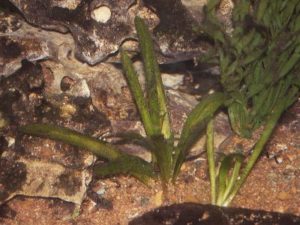
Vallisneria americana
Non-Herbicide Management Options
1. Physical Management Options
Eelgrass can be removed by cutting and raking it from the pond, but can re-establish from remaining roots.
Fertilization to produce a phytoplankton or algal “bloom” prevents the establishment of most bottom rooted aquatic weeds and produces a strong food chain to the pond fish.
Non-toxic dyes or colorants prevent or reduce aquatic plant growth by limiting sunlight penetration, similar to fertilization. However, dyes do not enhance the natural food chain and will suppress the natural food chain of the pond.
Some examples of non-toxic dyes and other products include but are not limited to:
Many types of mechanical removal devices are available that cut or chop up aquatic weeds. It is important to remember that many submerged plants regrow from fragments, so removal of cut fragments may be necessary to keep from spreading the unwanted plant.
Companies that make cutters and rakes include but are not limited to:
Physical barriers are also used to eliminate plants by shading the bottom. These work well for swimming areas, docks, etc. but must be kept clean of any buildup of sediment and debris.
Some examples of companies that make these mats are:
2. Biological Management Options
Grass carp will seldom control aquatic vegetation the first year they are stocked. They will consume eelgrass but it is not a preferred food item. Grass carp stocking rates to control eelgrass are usually in the range of 7 to 15 per surface acre. In Texas, only triploid grass carp are legal and a permit from the Texas Parks and Wildlife Department is required before they can be purchased from a certified dealer.
Herbicide Control Options
Always read the product label for directions and precautions, as the label is the law. Click on the name of the product to see the label. Read the label for specific water use restrictions.
The active ingredients that have been somewhat successful in treating Eelgrass include:
- Diquat (Rated: Fair)
- Endothall (Rated: Fair)
These rating are based upon the U.S. Army Corps of Engineers aquatic herbicide trials.
1) Diquat
Diquat is a contact algaecide and herbicide. Contact herbicides act quickly and kill all plant cells they come in contact with.
Common trade or product names include but are not limited to:
2) Endothall
Dipotassium salts of endothall comes in both liquid and granular forms. It can be mixed with copper compounds for additional effectiveness. Contact herbicides act quickly and kill all plant cells that they come into contact with.
Common trade and product names include but are not limited to:
Alkyl amine salts of endothall come in both liquid and granular forms. It is a contact herbicide.
Common trade and product names include but are not limited to:
Hydrothol can be toxic to fish.
Precautions
One danger with any chemical control method is the chance of an oxygen depletion after the treatment caused by the decomposition of the dead plant material. Oxygen depletion can kill fish in the pond. If the pond is heavily infested with weeds, it may be possible (depending on the herbicide chosen) to treat the pond in sections and let each section decompose for about two weeks before treating another section. Aeration, particularly at night, for several days after treatment may help control the oxygen depletion.
One common problem in using aquatic herbicides is determining area and/or volume of the pond or area to be treated. To assist you with these determinations see SRAC #103 Calculating Area and Volume of Ponds and Tanks.
Many aquatically registered herbicides have water use restrictions (See General Water Use Restrictions).
To see the labels for these products click on the name. Always read and follow all label directions. Check label for specific water use restrictions.
Cultivation Options
Eelgrass can be propagated by digging up whole plants and transplanting them into clear, shallow water.
Questions?
If you need assistance, contact the Ag & Natural Resources agent in your county or hire a professional.